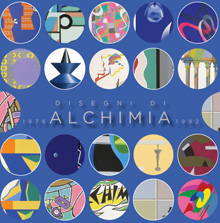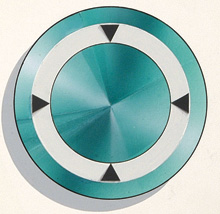 |
Disegni di Alchimia
1976-1992
a cura di Alessandro Guerriero e Remo Rapetti
postmedia books 2013
56 pp. -- 32 illustrazioni a colori
formato 150x150 mm.
testi in italiano e inglese

|
16,90 .
|
| |
limited edition
|
|
 |
Catalogo della mostra "Disegni Di Alchimia –1976-1992" a cura Alessandro Guerriero e Remo Rapetti e allestita all Istituto Italiano di Cultura in Toronto(October 1st - December 10th 2013).
"E`con grande piacere che l'Istituto Italiano di Cultura di Toronto presenta la mostra Disegni Di AlchimiA –1976-1992, una raccolta di 35 disegni, progetti ed elaborazioni grafiche che documentano la creatività del movimento Alchimia. Fondato a Milano dall'architetto e designer Alessandro Guerriero e da sua sorella Adriana nel 1976, Alchimia è stato uno dei centri più vitali ed innovativi del design italiano di post-avanguardia, una fucina di idee, progetti, ricerche che spaziavano dall'architettura al decoro, al design d'interni, al mobile, l'abbigliamento, la scenografia, la pittura. Un laboratorio nella miglior tradizione del Rinascimento italiano, dove architetti e designer quali Alessandro Mendini, Andrea Branzi, Ettore Sottsass, Michele De Lucchi e Paola Navona, oltre ad artisti, grafici e stilisti hanno dato vita a sperimentazioni ardite e fantastiche.
Il punto di partenza era costituito dal disegno. Come indicato nel manifesto, per Alchimia il disegno rappresenta un "libero e continuo movimento del pensiero" dal quale scaturiscono le idee. Idee che vengono diffuse attraverso scritti teorici e mostre, dando vita al cosiddetto "Design Romantico". Un design nel quale le discipline si intersecano, dialogano tra loro, trasformano oggetti e funzioni, rivoluzionando l'editoria, la grafica, la scultura e la pittura. Si pensi al tavolo disegnato da Alessandro Mendini per la serie "Mobile Infinito", decorato da Francesco Clemente, Sandro Chia e Mimmo Paladino, oltre a Giò Ponti, Bruno Munari e Luigi Veronesi. O si consideri l'influsso esercitato dalla rivista Domus diretta da Mendini nella prima metà degli anni 1980 nella diffusione a livello internazionale del design postmoderno. Per il loro fondamentale lavoro di ricerca molti dei membri del gruppo sono stati insigniti del prestigioso "Compasso d'Oro", assegnato nel 1982 ad Alessandro Guerriero.
Desidero ringraziare Alessandro Guerriero, curatore della mostra e Remo Rapetti, coordinatore della produzione, per aver voluto esporre questa mostra a Toronto e Alitalia e Azure per il loro sostegno". (dall'introduzione di Adriana Frisenna)
|
|
 |
"Faithful to the transitional era in which we live, Alchimia adopts a more traditional method for confronting everyday culture; it tries to liberate the commonplace and the ordinary from its kitsch aspects in order to raise it to a level of high culture. This attitude is slightly ambiguous, but it demonstrates that this group attempts to reject the limitations of elite and bourgeois culture in order to gain access to a new, more accessible and more popular cultural approach – a sort of intermediate position between kitsch and "good design", tainting both of them". (François Burkhardt 1986)
"The Atelier Alchimia, for example, has a sort of hectic need, an obsession of drawing, of coloring white cardboards by watercolors and acrylic colors. Every artist has and tries to bring to perfection his/her specific technical capacities, which make him/her a virtuoso in the ratio between the idea quality and the strength of the object produced. Alchimia's virtuosity focuses on an ancient mania of drawing. Now I wish to concentrate on a precise aspect of this Drawing Need. As a fugitive (almost) from built architecture, I love all the "architecture dreams". We need, today, far, very far objects but they should be perfect. While life (and ideas) moves in a hectic way, some designers-poets keep on drawing, to be an antidote to making and building cruelty. It deals with Drawing/Drawing, with a paradox complete and defined "in itself". It deals with imaginary "things", mental objects located in ideal places, inside time-spaces which plunge into skies of metaphysical nostalgia. These things are often unsuitable to people's presence, they are complex conceptual symbols, sucked out of life, which would need a perfect man's presence, but he is absent in those drawings, he "is not there". It happened with Sant'Elia, it happens now with some Trend and Post-modern Masters, whom it is useless to name, it happens also with Alchimia that traces hundreds of sketches and drawings, using pointed and soft lines, pothooks, dots, textures, flying flags, planes and volumes, sharp or delicate tones, an endless variation of images which evoke its utopistic town, "Alchimia Town". Design, you know, does not coincide only with the work produced, and it is up-to-date the controversy between design-painting and painting design, since when the philosophical gradient that a project entails is considered fundamental in evaluating it. Drawing and object are superimposed; communication becomes reality just when it acquires "volume"". (Alessandro Mendini 1987)
|
|
|
Alessandro Guerriero è uno a cui piace cambiare le regole. Lo fa da oltre trent'anni. Almeno da quando, nel 1976, fondò Alchimia, il gruppo di designer che diedero faccia e idee alla post-avanguardia italiana. Se c'è da far saltare uno schema, piegare la realtà o soltanto colorare un pensiero, Guerriero non si tira mai indietro. Parla con un vocabolario tutto suo. Un vocabolario in cui l'aggettivo da mettere di fianco alla pa- rola "Design" è "Romantico" (ha chiamato così, la teoria con cui guarda al suo mestiere). I lavori di Guerriero sono ovunque – dal Museo d'Arte Moderna di Tokyo, al Metropolitan Museum di New York – ma il suo sguardo caleidoscopico si è posato anche sugli spazi meno ortodossi per l'architettura e il design. Alessandro Guerriero ha reinventato giornali (come quando nel 1988 ha editato OLLO - Rivista senza Messaggio), concerti e teatri (con i suoi progetti scenografici per i Matia Bazar e i Magazzini Criminali), carceri (con la Cooperativa del Granserraglio, composta da detenuti in semilibertà), scuole (fondando, nel 1987, la Domus Academy e poi, nel 1995, il Futurarium di Ravenna, un laboratorio didattico dove imparare la "dissolvenza delle discipline"). Il "Compasso d'Oro" 1982. Alessandro Guerriero è oggi docente al Politecnico di Milano e presidente della Naba, la Nuova Accademia di Belle Arti di Milano. Per Absolut World ha disegnato il muro alle Colonne di San Lorenzo e per non lasciare in pace nessuno ha lanciato il Compasso di Latta qualche ora fa.
Alessandro Guerriero is someone who likes to change rules. He has been doing it for more than thirty years, at least since 1976, when he established Alchimia, the designer group who gave faces and ideas to Italian post-avant-garde. If it deals with rebelling against conventions, bending reality or just with colouring a thought, Guerriero does never withdraw. He speaks with a very personal vocabulary, in which for example the adjective to put together with the word "Design" is "Romantic" (as he called the theory behind his trade). Guerriero's works are everywhere – from the Museum of Modern Art in Tokyo to the Metropolitan Museum in New York – but his kaleidoscopic glance rested also on locations which were considered less orthodox for architecture and design.
Alessandro Guerriero reinvented newspapers (like when in 1888 he published OLLO – Message less magazine), musical shows and theatres (with his stage sets for the groups Matia Bazar and Magazzini Criminali), jails (he created the Granserraglio Cooperative, made up of inmates on work release), schools (he founded in 1987 Domus Acad- emy in Milan and in 1995 Futurarium in Ravenna, a teaching workshop where one could learn "the fade of disciplines". In 1982 he was awarded the "Compasso d'Oro" prize. Alessandro Guerriero is now teaching at the Politecnico in Milan and is President of NABA, Nuova Accademia
di Belle Arti in Milan. For the event Absolut World he made drawings on the wall of San Lorenzo Columns in Milan and, just to give nobody any peace, he launched the Tin Compass a few hours ago.
|
postmedia books
postmedia•books in english |
|
|
|
|
|
|
|
|